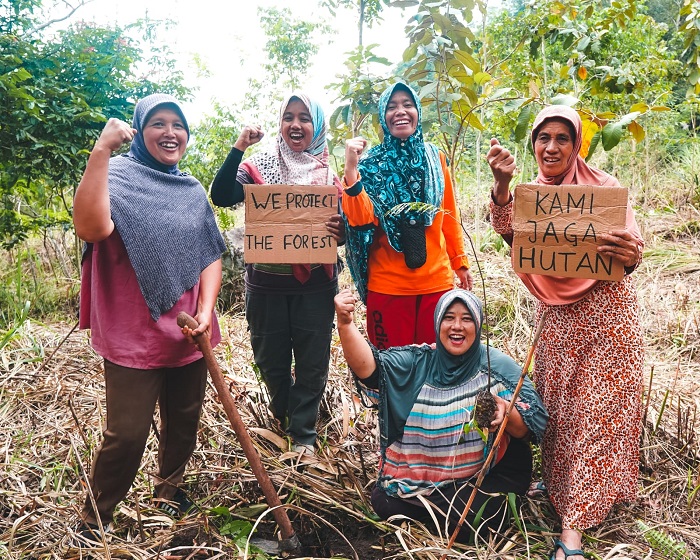Farwiza Farhan & J Prio Sambodho
When it comes to big problems like deforestation and climate change, we tend to like BIG solutions. Most discussion of conservation and climate science today involves complex data, and high-level multinational agreements are sealed in luxurious hotels. But many of the most important solutions happen on the ground, by actors who don’t walk the corridors of power but are dealing with the impacts of deforestation every day. This essay provides a ground-level view of a conservation initiative focused on the forest community.
‘Traditional’ conservation focuses on ‘ring-fencing’ – keeping everything and everyone out – but this new approach focuses on helping communities conserve and protect the forest by making them the key stakeholders. The small village of Damaran Baru is situated on the edge of the famous Mount Leuser National Park. A women-led ranger team from the village has had success in not only promoting conservation in the area but also increasing agency of the women involved. The initiative has been supported by the Acehnese conservation group Hutan Alam dan Lingkungan Aceh (HAkA), where one of us (FF) works. We would like to provide a glimpse into how this works in practice – its successes and failures, its potential and challenges for the future.
Logging
One day in 2015, suspecting a problem with their water source, a group of Damaran Baru villagers trekked upstream into the forest towards the mountain. Over the previous days, the usually clear and pristine water in the streams that flowed from deep inside the forest had turned muddy. What they saw surprised them. Timber from a huge landslide had jammed the river. The landslide came from a patch of forest that had been stripped clean by loggers. The heavy rain of that long rainy season had loosened the soil. Seeing that, they knew the muddy water was just the beginning. They were witnessing an impending disaster. It didn’t take long for their fears to materialise. Within a week, a flash flood broke out and swept through the village of Damaran Baru and neighbouring villages. Hundreds of villagers were forced to evacuate and live in refugee camps for more than a month, under conditions they described as ‘horrible and unsanitary.’ The experience was especially pronounced for the women. Access to water and sanitation was problematic, not to mention the lack of privacy.
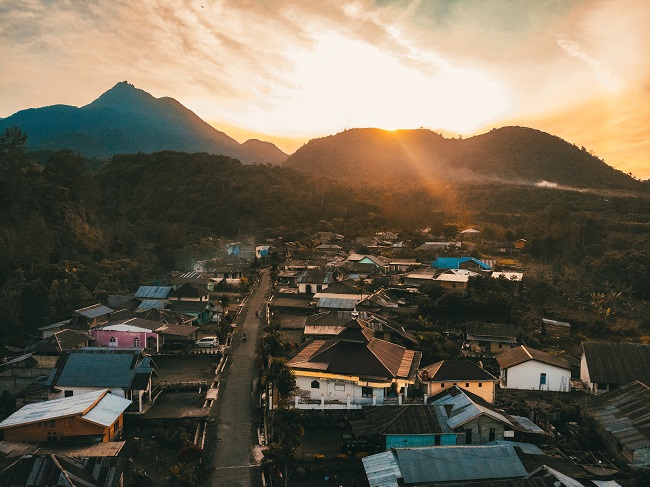
Before the flash flood of 2015, smaller floods were an annual occurrence in Damaran Baru. The village is located in the foothills of a mountain called Puncak Damaran. With large and strong streams and steep slopes, the area is naturally vulnerable to landslides. The villagers have always been aware that these floods are mainly caused by logging and land clearing upstream – common practices since the late 1990s, when people started moving there in great numbers. Initially, most people considered the floods and landslides a nuisance rather than a disaster but as far back as 2009 some were already aware of the danger they faced. They formed a small community-based organisation called Bumi Telong, named after another nearby mountain. The group cautioned other villagers of the danger from uncontrolled logging upstream. They began organising informal treks up the mountain with a group of villagers to warn off and discourage illegal loggers. The 2015 flash flood vindicated their concerns and interest in taking a more active role in protecting the forest grew among the Damaran Baru villagers.
In 2017, a group of Damaran Baru women participated in environmental paralegal training conducted by the local conservation NGO, HAkA. They expressed their desire for more concrete action to protect the forest ‘up the mountain’. With the support of HAkA, a group of villagers, led by Bumi Telong activists, formed a Village Forest Management Institute (Lembaga Pengelolaan Hutan Desa, LPHD). They elected Sumini, one of their activists, as their chairwoman. Soon after, they applied for a village forest permit under the, then newly rolled-out, Social Forest Initiative. The process took about a year, from multiple village discussions and consultation with the district government to mapping boundaries and compiling necessary documents for the application. In November 2019, the Ministry of Environment and Forestry finally issued a village forest permit for Damaran Baru, amounting to 251 hectares.
Patrols
Permit in hand, LPHD together with the community then drafted a management plan for the village forest. This included forming the Damaran Baru LPHD ranger team in January 2020. Led by Sumini, the ranger team is Aceh’s first-ever women-led ranger team. Their main task is to patrol the Damaran Baru village forest to discourage logging and land encroachment. Its personnel are comprised of LPHD members, many of them women, together with their close male relatives: husbands and sons. The organisational structure is divided into three areas. The first has three rotating teams, each of eight individuals, both men and women. Each team goes out on daily patrol for five days a month. Next is an overnight team, composed of five men, who go out on longer, overnight patrols farther into the forest. Third is a restoration team, composed of all women. It engages in restoration activities – planting seeds and preparing seedlings to be taken to the restoration area.
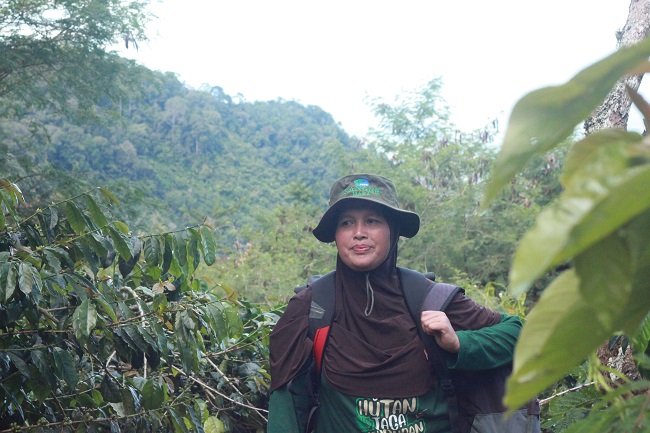
Since these ranger groups started patrolling, the incidence of illegal logging and encroachment in the Damaran Baru forest continues to decline. They owe their success mainly to their persuasive approach. When they come across illegal loggers, the women patrol members take the lead. Instead of confronting them, they will ask the logger to sit down, perhaps offer them some of their packed food, and start a conversation. This usually starts casually. Which village do they come from? What about their family? Many loggers are in fact also their acquaintances. Along the way, they gently inform them of the protected status of the area. They plead for them to stop. The ranger will then let the loggers take anything they have cut down. They make no attempt to take away any of their equipment or threaten them with criminal sanctions. Their gentle approach disarms conflict before it escalates. Faced with this approach, the loggers and encroachers tend to back down. ‘Women are much more effective in protecting forests,’ Sumini told us. ‘When we ask the illegal loggers to stop logging, they feel so ashamed [of being told off by elderly females] and they will stop [logging].’ The rangers understand the importance of maintaining this peaceful resolution. They are consolidating and gaining support among the villagers. This is key to the continuation of their effort to protect the forest.
The success of the rangers can also be credited to their embeddedness in the community. Being a ranger is only part of Sumini and other women rangers’ role in the community. They are also coffee growers, honey farmers, tempe makers, wives, mothers and grandmothers. Simply put, they are part of the community. They use their role as family caretakers and community members to support their role as forest protectors. Oftentimes, during friendly, neighbourly meetings, called ‘arisan’, or ahead of a village event such as a wedding, as they chop vegetables and prepare food together, they will take the opportunity to gossip, share stories and explain their mission to protect the forest to the other women. They invite them to join in. Such events allow for a compassionate and grounded exchange of thoughts among villagers about their daily interaction with the forest. Conservation in this sense becomes very practical. How much forest can they clear and use sustainably? What things can they take out of the forest, and what things not? Are there perhaps better alternatives? More importantly, these questions come not from someone far away, but from one of their own.
Clout
Beyond its success in reducing the incidence of logging, the women-led ranger team also serves as an avenue for women in Damaran Baru to build their agency and political clout in the everyday life of the village. Having a role in the ranger team affords women the opportunity to share a stage with the Ministry of Forestry when speaking to the national, and even the foreign, media. They are honing their public speaking skills. They are getting better at articulating problems they’re facing on the ground. Although these women do not hold a formal position in the village government, their increasing popularity gains them broad support. They become more involved in village meetings, they engage in discussion over the village budget and they even get to represent the village at provincial and central government events. Such engagements nurture their confidence. They can even build a case for reallocating village funds – they successfully lobbied the village head to build them two resting gazebos in the restoration area.
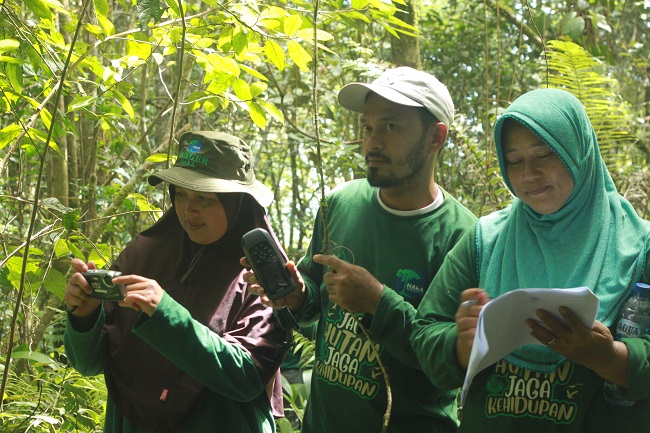
All this success is not without challenges. Political contest among competing interests is a constant. Initially, villagers with coffee plantations in the village forest area assumed the forest initiative was a full handover of forest management from the state to the villagers. They were very supportive of the process. However, as it became clear to them that the LPHD management plan hinged on conservation, they began to feel uneasy. How would this affect the future of their coffee plantation, in which they had invested so heavily? Support began to turn into animosity and rumours spread that undermined the credibility of certain LPHD members. Being a member of the ranger team thus went beyond patrolling. It also meant engaging in daily political negotiation, navigating the intricacies within the community.
Secondly, while the women-led ranger initiative is a success in Damaran Baru, it could be more challenging to replicate it in other parts of Aceh. While located in Aceh, the village of Damaran Baru is dominated by descendants of Javanese migrants. They often identify as Java-Gayo. Culturally, the men and women of Damaran Baru tend to apply rather egalitarian gender values. Open displays of support by men for their wives’ public role outside the household is rather unique within the relatively male-dominated context of rural Aceh. How applicable is this initiative in Aceh more broadly?
It also remains to be seen how this women-led ranger team and its larger LPHD initiatives will continue beyond HAkA’s institutional support. HAkA experience has been that the process of developing an initial institutional capacity is complex and resource-intensive. Since then, HAkA facilitators have worked intensively with the LPHD members to develop an annual work plan and an organisational strategic plan. Such resources and supportive commitment may not always be available elsewhere, nor easily replicable.
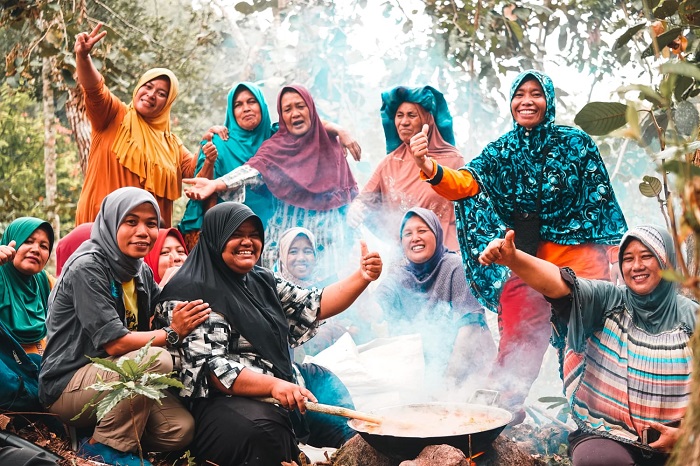
At the end of the day, this women-led ranger team may or may not continue, as many other conservation initiatives have come and gone. Yet, understanding the actions of Sumini and her peers only from the frame of success or failure of this ranger team may be too limiting. This would be a disservice to her and all the women rangers of Damaran Baru, who dedicate their lives every day to conserve and protect their forest, even after they have taken off their ranger team uniforms. Indeed, in the words of Sumini herself ‘We were already doing what we are doing before HAkA came along. But with the support of HAkA we became famous. We have [been given] the gear and equipment necessary to protect our forest but this work to protect the forest has always been ours’.
Instead of focusing on success or failure, more attention should be paid to understanding how the women use this program to build their political clout and consolidate support amongst the villagers. How they deploy their creativity to leverage the relationship with an external NGO to amplify their own story, and how they use all these networks to gain resources to support their agenda in everyday village politics. The women of Damaran Baru might not speak the language of nature-based solutions, they might have no idea how their work contributes to climate mitigation and adaptation, but they understand the direct relationship between tree cover and human beings. They know a bad relationship leads to natural disaster. And they are willing to fight to restore that relationship for the good of both.
Farwiza Farhan (farwiza@gmail.com) is the chairwoman of Hutan Alam dan Lingkungan Aceh (HAkA). J. Prio Sambodho (priosambodho@gmail.com) is a researcher and lecturer in the Sociology Department, University of Indonesia.
